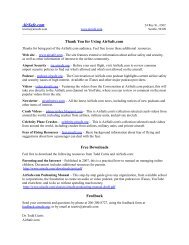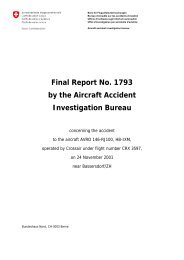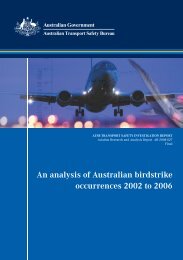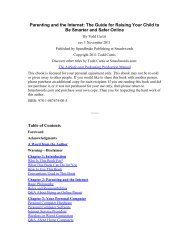AAIB Investigation Updates (PDF) - Airline Safety and Security ...
AAIB Investigation Updates (PDF) - Airline Safety and Security ...
AAIB Investigation Updates (PDF) - Airline Safety and Security ...
Create successful ePaper yourself
Turn your PDF publications into a flip-book with our unique Google optimized e-Paper software.
<strong>AAIB</strong> Interim Report G-YMMM EW/C2008/01/01<br />
Fuel System<br />
A pressure <strong>and</strong> vacuum check was carried out on the<br />
aircraft fuel feed system, <strong>and</strong> all of the pipelines were<br />
inspected by videoscope before the main mechanical <strong>and</strong><br />
electrical components were removed for examination<br />
<strong>and</strong> testing. In addition, the entire left fuel feed system<br />
was removed from the aircraft, all the seals were<br />
inspected <strong>and</strong> the system was reassembled at the <strong>AAIB</strong><br />
facility at Farnborough. The surge tank pressure relief<br />
valves, which had not operated in flight, were tested<br />
<strong>and</strong> found to be serviceable <strong>and</strong> there was no structural<br />
deformation to the fuel tanks which would have resulted<br />
from a blockage in the vent system.<br />
The examination <strong>and</strong> testing found no faults in the<br />
aircraft fuel system that could have restricted the fuel<br />
flow to the engines.<br />
Engines<br />
With the exception of the two EECs <strong>and</strong> the FOHE/<br />
LP filter assemblies, most of the engine control system<br />
components, located beneath the engine, were too badly<br />
damaged or contaminated with dirt <strong>and</strong> fire fighting media<br />
to be functionally tested. However, all components were<br />
strip‐examined <strong>and</strong> individual sub‐assemblies tested<br />
where possible.<br />
No pre‐existing defects or evidence of abnormal<br />
operation were found with the exception of signs of<br />
abnormal cavitation erosion on the delivery side of both<br />
HP pumps. Some small debris was recovered from<br />
the left FOHE inlet chamber but this would not have<br />
restricted the fuel flow. Both of these observations<br />
have been reported in previous <strong>AAIB</strong> Special Bulletins,<br />
01/2008 <strong>and</strong> 03/2008.<br />
The EECs, whose NVM was successfully downloaded<br />
© Crown copyright 2008<br />
10<br />
soon after the accident, have not been tested because to<br />
do so would require erasing the installed software <strong>and</strong><br />
loading special test software. Since the recorded data <strong>and</strong><br />
the NVM indicate that there were no anomalies with either<br />
EEC, testing of these units is not currently planned.<br />
Fuel loading<br />
G‐YMMM was refuelled at Beijing with 71,401 kg of<br />
No 3 Jet Fuel (Peoples Republic of China), at a fuel<br />
temperature of 5°C (41 o F); the refuelling was completed<br />
30 minutes before the engines were started for the return<br />
flight to Heathrow <strong>and</strong> the total fuel load was 79,000 kg.<br />
At the start of the flight the recorded temperature of the<br />
fuel in the left main tank was ‐2°C (28°F). No 3 Jet<br />
Fuel complies with the UK <strong>and</strong> USA specifications for<br />
Jet A‐1.<br />
The FDR shows that at the time of the accident the total<br />
fuel on the aircraft was 10,500 kg, with 5,100 kg in<br />
the left main tank <strong>and</strong> 5,400 kg in the right main tank.<br />
Following the accident, approximately 6,500 to 7,100 kg<br />
of fuel had leaked out of fractured engine fuel pipes<br />
before the spar valves were manually closed.<br />
Fuel testing<br />
Following the accident, 66 fuel samples were taken from<br />
the aircraft <strong>and</strong> the engines. A number of these samples<br />
were tested <strong>and</strong> critical properties such as the freezing<br />
point, density, flash point, viscosity, contamination, fuel<br />
additives <strong>and</strong> presence of water were tested against DEF<br />
STAN 91‐91 <strong>and</strong> ASTM D1655 requirements 2 . The fuel<br />
samples complied fully with the fuel specifications for<br />
Jet A‐1. Additional tests were carried out to detect any<br />
unusual components that would not normally be found<br />
in aviation turbine fuels. No evidence of contamination<br />
Footnote<br />
2<br />
DEF STAN 91-91 <strong>and</strong> ASTM D1655 contain the st<strong>and</strong>ard<br />
specifications for aviation turbine fuels.











